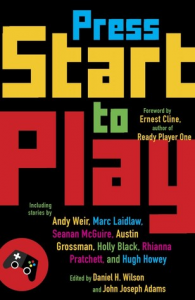
Today I finished reading “Press Start to Play” by Daniel H. Wilson
Somebody needs to think about this stuff...
by justin

Today I finished reading “Press Start to Play” by Daniel H. Wilson
by justin
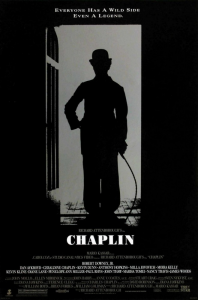
Chaplin
Today I watched “Chaplin”
by justin
There have been serious but non-fatal crashes directly connected to Pokemon Go.
In early 2007 I wrote a rather prophetic piece.
This was just prior to Apple’s iPhone announcement if I recall correctly. Though don’t hold me to that.
People said that it was ridiculous… “Well that will never happen. You need to give people more credit.”
I think I was far too conservative in my outlook. I wish now I had thrown in some forward looking statements about Augmented Reality.
by justin
Twitter has always felt to me like the collective wisdom of a bunch of 12-year olds who are angry because they don’t understand something.
P.S. I include myself in that group. Don’t follow me unless you enjoy profanity spewed about things I don’t understand.
by justin
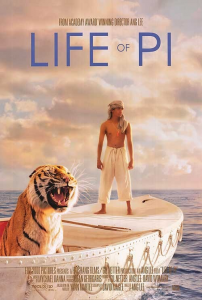
Life of Pi
Today I watched “Life of Pi”
I know they are CGI and I know it’s only a film, but I cried for the poor animals on the boat.
“What about the humans Justin?”
There were humans?
by justin

This week I am listening to “Harmlessness” by The World Is A Beautiful Place And I Am No Longer Afraid To Die
by justin
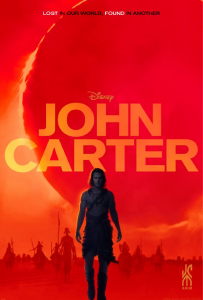
John Carter
Today I watched John Carter.
Swashbuckling tale sort of tangentially related to the book.
Not quite a “Do androids dream of electric sheep?” re-write but enough to confuse the hell out of me after a 30 year span from when I first read the novel.
by justin
Read that lengthy Atlantic article. I’ll wait. Read it? Good. Let’s proceed.
“That is insane.” was a common complaint.
Watch the documentary of “The Land” by Erin Davis and read the article.
At the end, my wife and I turned to each other and chorused.
“No! That is fucking awesome!”
I strongly believe we are heading to a crisis within American (and UK) industry, science and technology due to the over-protective parenting style.
We want better for our kids, and “better” equates as safer in a lot of our culture when it comes to our future.
But “safer” isn’t “better” when the outcome 40 years later is worse because we no longer have children who are now adults who are willing to take risks and “figure it out on their own.”
And then we lose.
We lose because future industry leaders in other cultures won’t have that risk averse nature.
We lose because future industry leaders in other cultures will be willing to figure it out on their own.
We lose because future industry leaders in other cultures are willing to experiment.
We lose because future industry leaders in other cultures are willing to set fire to things.
And we lose because future industry leaders understand that there isn’t anybody ready to swoop in and save them from themselves.
by justin

BioSpaun: A large-scale behaving brain model with complex neurons
Today I read a paper titled “BioSpaun: A large-scale behaving brain model with complex neurons”
The abstract is:
We describe a large-scale functional brain model that includes detailed, conductance-based, compartmental models of individual neurons. We call the model BioSpaun, to indicate the increased biological plausibility of these neurons, and because it is a direct extension of the Spaun model. We demonstrate that including these detailed compartmental models does not adversely affect performance across a variety of tasks, including digit recognition, serial working memory, and counting. We then explore the effects of applying TTX, a sodium channel blocking drug, to the model. We characterize the behavioral changes that result from this molecular level intervention. We believe this is the first demonstration of a large-scale brain model that clearly links low-level molecular interventions and high-level behavior.
by justin
I do not know why we need five different conditioners, three shampoos and four types of bubble bath.
Is this like a “wine” thing where people pontificate on nose, mouth feel, regions and varietals?
Is there such a thing as a soap sommelier?
by justin
Today I read a paper titled “Progressive Gaussian Filtering”
Fuck me! Nice feedback filtering and sampling system!
The abstract is:
In this paper, we propose a progressive Bayesian procedure, where the measurement information is continuously included into the given prior estimate (although we perform observations at discrete time steps). The key idea is to derive a system of ordinary first-order differential equations (ODE) by employing a new coupled density representation comprising a Gaussian density and its Dirac Mixture approximation. The ODE is used for continuously tracking the true non-Gaussian posterior by its best matching Gaussian approximation. The performance of the new filter is evaluated in comparison with state-of-the-art filters by means of a canonical benchmark example, the discrete-time cubic sensor problem.
by justin
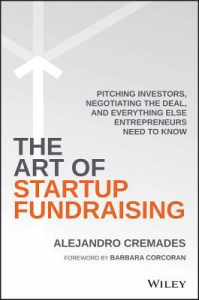
The Art of Startup Fundraising
Today I finished reading “The Art of Startup Fundraising” by Alejandro Cremades
by justin
This week I studied “Developing Ideas and Design Concepts”
This is an online class from Lynda.com.
The class consists of just a hair under two hours of video.
I logged a total of 2 hours of “class time” and an additional 8 hours of sketching, laying out concepts, brainstorming, and working on sample project briefs.
by justin
Was at a tech mixer/meet-up/networking thingy in Silicon Valley area just before July 4th holiday.
“And we have a lot of machine learning in here” said the entrepreneur, indicating his app.
“It’s classifying product categories automatically based on the description and the manufacturer?” I ask.
The entrepreneur nods.
“A Naïve Bayes classifier then.” I add.
The technical cofounder, silent until now, eagerly starts to explain how he implemented it in NodeJS with an off-the-shelf gem.
“No, no, far more than that. We have a lot of machine learning in our app. This is Deep A.I.” said the business co-founder using air quotes.
I swear you could see the italics.
I looked at the technical co-founder without saying a word. He continued to babble about Naive Bayes and gems and NodeJS.
I asked about scaling the P values and if he was using a logarithmic function.
The run-on-sentences stopped. The response was slow and thoughtful. “I think that’s how I stop the values always trending to near zero. I don’t really understand that part.”
I nod politely. “Nothing wrong with that. Use whatever works, even if you aren’t sure you fully understand how it works.” I say encouragingly.
“Dude, shut up, you’re talking about stuff we’re trying to patent.” said the business co-founder impatiently.
“It’s just a Bayes classifier” opined the technical co-founder.
The business co-founder looked pained. “He doesn’t really mean that. It’s more complicated.”
I nod again, just as politely.
I pause.
“Did you try a Laplacian smoothing algorithm? Or additive smoothing?” I asked knowing full well that Laplacian applies to polygonal meshes and that additive smoothing and Laplace smoothing are one and the same.
“Yes” said the business co-founder.
“I don’t know what those are.” said the technical co-founder the merest fraction of a second behind.
“Have you solved the overfitting to data problem?” I asked the business co-founder. A Naive Bayes classifier generally doesn’t suffer that problem.
“Of course. I won’t deny we had some trouble, but we overcame the overfitting issue.”
I nod again.
The technical co-founder looks like a deer caught in headlights.
“This is a very nice looking app” I said to the business co-founder. “But I will give you one piece of advice.” I didn’t look up from his phone that I was holding on to. I was still swiping through the screens of the app. “When you talk to potential investors, do not bullshit them about your technology. It’s no fun to lose out on an investment during the due diligence phase. The tech guys working for VCs are a lot sharper than I am.”
Now I had two deer caught in the headlights.
by justin

This week I am listening to “What A Terrible World, What A Beautiful World” by The Decemberists
by justin

Usagi Yojimbo : Senso
Today I finished reading “Usagi Yojimbo: Senso” by Stan Sakai
by justin
On the one hand, I must count my blessings that my wife is willing to make me a cappuccino and take care of me.
On the other hand, I must question how she has the capacity to turn out the foulest tasting drink from a Jura J9 that requires you to put a cup under the spout and press one button.
But I still count my blessings though.
And cherish every cup she brings me.
by justin
“Are you looking to hire me or get hired by me?” I asked the random number that interrupted my deep-in-the-code train of thought.
The person on the either end of the line had awkwardly introduced himself as “Bob” though judging by his accent I doubted the veracity of that claim.
Bob had made a long rambling introduction and I had abruptly questioned him about what his intentions were: hire? Or get hired?
The number on my Android Nexus had displayed as a “spam call” from somewhere in New York according to the reverse number software. I had apparently missed several calls from this number over the past couple of days.
“I was asked by my CEO to give you a call. We’re an IT company…”
IT?
The truthfullness of “Bob’s” claim to his name was under no further doubt.
Unless his parent’s were weird and gave him “Bob” because they were the Asian equivalent of “children of the 60’s.”
“I don’t outsource any of our IT functions, thanks for the call.” I was eager to return to my code.
“No, wait!” exclaimed Bob. “We’re looking to hire your expertise.”
“Oh, I see. What seems to be the problem you have?”
“My CEO looked at your online profile. And he thought you’d be able to help us. We specifically need your IT expertise.”
“What part of my expertise?”
“We are an IT outsourcing company. We have clients that have problems. You can help us solve those problems. We want to establish you are an expert. We have put together this online test for you to take. It should take a couple of hours to complete.”
*click*
*ring* *ring*
“Yes?”
“We got disconnected.” opined Bob.
“No, I hung up on you.”
*click*
by justin
“I can’t eat here,” said the lunchtime acquaintance, “I’m severely gluten intolerant.”
“Oh really? I’m sorry to hear that. What are the specific symptoms you exhibit?” I asked politely.
“I’m just intolerant that’s all.” he replied.
“But specifically, how do the symptoms present themselves?” I was curious. I was polite.
“I just feel bad.” said the business contact irately.
I nodded sympathetically.
We settled for the over-priced “build your own” salad next door.
We ate our meal over polite conversation.
I constantly diverted away from business discussions and working together.
And ultimately I decided not to pursue any possibility of future business.
Affectation is a metaphor.
P.S. I am actually mildly gluten intolerant but that won’t ever stop me from consuming vast quantities of fresh baked bread and freshly rolled pasta.
by justin
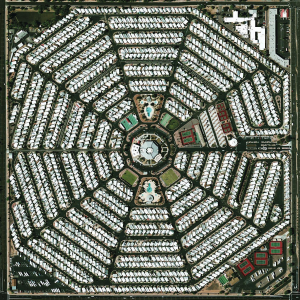
This week I am listening to “Strangers To Ourselves” by Modest Mouse
by justin
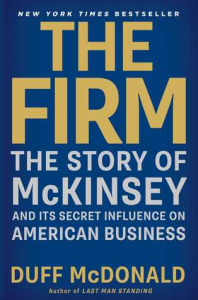
The Firm – The Story of McKinsey and its secret influence on American business
Today I finished reading “The Firm: The Story of McKinsey and Its Secret Influence on American Business” by Duff McDonald
by justin
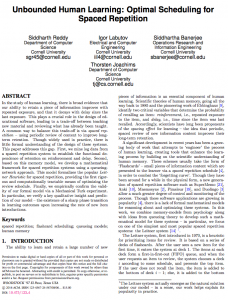
Unbounded Human Learning: Optimal Scheduling for Spaced Repetition
Today I read a paper titled “Unbounded Human Learning: Optimal Scheduling for Spaced Repetition”
I like the fact that there is an empirical evaluation of the results against an actual audience and not just merely conjecture. The queuing implementation is useful. My concern is with “human boredom” that could arise from a badly tuned, automatic system (though no worse than a badly tuned system designed by a human). We want to help the subjects memorise what they need, but we also need to keep feeding them novel, i.e. new, knowledge to keep them engaged.
The abstract is:
In the study of human learning, there is broad evidence that our ability to retain information improves with repeated exposure and decays with delay since last exposure. This plays a crucial role in the design of educational software, leading to a trade-off between teaching new material and reviewing what has already been taught. A common way to balance this trade-off is spaced repetition, which uses periodic review of content to improve long-term retention. Though spaced repetition is widely used in practice, e.g., in electronic flashcard software, there is little formal understanding of the design of these systems. Our paper addresses this gap in three ways. First, we mine log data from spaced repetition software to establish the functional dependence of retention on reinforcement and delay. Second, we use this memory model to develop a stochastic model for spaced repetition systems. We propose a queueing network model of the Leitner system for reviewing flashcards, along with a heuristic approximation that admits a tractable optimization problem for review scheduling. Finally, we empirically evaluate our queueing model through a Mechanical Turk experiment, verifying a key qualitative prediction of our model: the existence of a sharp phase transition in learning outcomes upon increasing the rate of new item introductions.
by justin
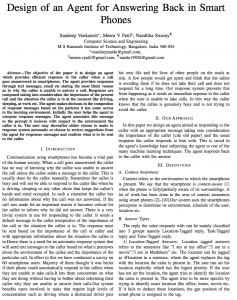
Design of an Agent for Answering Back in Smart Phones
Today I read a published paper titled “Design of an Agent for Answering Back in Smart Phones”
Shallow fluff with obvious solutions to obvious problems.
The abstract is:
The objective of the paper is to design an agent which provides efficient response to the caller when a call goes unanswered in smartphones. The agent provides responses through text messages, email etc stating the most likely reason as to why the callee is unable to answer a call. Responses are composed taking into consideration the importance of the present call and the situation the callee is in at the moment like driving, sleeping, at work etc. The agent makes decisons in the compostion of response messages based on the patterns it has come across in the learning environment. Initially the user helps the agent to compose response messages. The agent associates this message to the percept it recieves with respect to the environment the callee is in. The user may thereafter either choose to make to response system automatic or choose to recieve suggestions from the agent for responses messages and confirm what is to be sent to the caller.
by justin

Study of Gesture Recognition methods and augmented reality
Today I read a paper titled “Study of Gesture Recognition methods and augmented reality”
Difficult to read due to the stilted language but not due to the content. The content of the study was not that revealing in terms of new knowledge. I guess it would be useful if I wasn’t already familiar with the subject and just need a quick overview.
The abstract is:
With the growing technology, we humans always need something that stands out from the other thing. Gestures are most desirable source to Communicate with the Machines. Human Computer Interaction finds its importance when it comes to working with the Human gestures to control the computer applications. Usually we control the applications using mouse, keyboard, laser pointers etc. but, with the recent advent in the technology it has even left behind their usage by introducing more efficient techniques to control applications. There are many Gesture Recognition techniques that have been implemented using image processing in the past. However recognizing the gestures in the noisy background has always been a difficult task to achieve. In the proposed system, we are going to use one such technique called Augmentation in Image processing to control Media Player. We will recognize Gestures using which we are going to control the operations on Media player. Augmentation usually is one step ahead when it comes to virtual reality. It has no restrictions on the background. Moreover it also does not rely on certain things like gloves, color pointers etc. for recognizing the gesture. This system mainly appeals to those users who always looks out for a better option that makes their interaction with computer more simpler or easier.
by justin
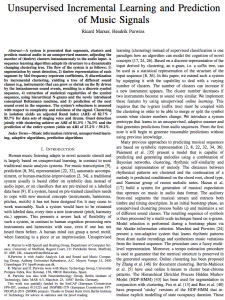
Unsupervised Incremental Learning and Prediction of Music Signals
Today I read a paper titled “Unsupervised Incremental Learning and Prediction of Music Signals”
Part of some personal research work I am doing with music generation software.
The abstract is:
A system is presented that segments, clusters and predicts musical audio in an unsupervised manner, adjusting the number of (timbre) clusters instantaneously to the audio input. A sequence learning algorithm adapts its structure to a dynamically changing clustering tree. The flow of the system is as follows: 1) segmentation by onset detection, 2) timbre representation of each segment by Mel frequency cepstrum coefficients, 3) discretization by incremental clustering, yielding a tree of different sound classes (e.g. instruments) that can grow or shrink on the fly driven by the instantaneous sound events, resulting in a discrete symbol sequence, 4) extraction of statistical regularities of the symbol sequence, using hierarchical N-grams and the newly introduced conceptual Boltzmann machine, and 5) prediction of the next sound event in the sequence. The system’s robustness is assessed with respect to complexity and noisiness of the signal. Clustering in isolation yields an adjusted Rand index (ARI) of 82.7% / 85.7% for data sets of singing voice and drums. Onset detection jointly with clustering achieve an ARI of 81.3% / 76.3% and the prediction of the entire system yields an ARI of 27.2% / 39.2%.
by justin
Best proposition I ever got was when I was (much) younger.
I played in a small-time punk band and we were about a week away from going on tour in Germany.
Somebody I didn’t know very well at all who was in my Tang-Soo Do karate class, whose band played free gigs of cover songs at local student bars, said “If you write this software for free for my Dad’s business we’ll let you play a few sets with our band sometime.”
Awesome!
Not only do I get to do free software development work for the Dad (which I already get paid really well for), but you’ll let me play in your shitty student band for free too!
Double win!
by justin
I am a great believer that you should always make sure that the woman you’re seeing and the whisky you drink are of the same age.
I have started to drink some very expensive whisky.
by justin
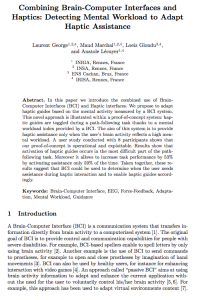
Combining Brain-Computer Interfaces and Haptics: Detecting Mental Workload to Adapt Haptic Assistance
Today I read a published paper titled “Combining Brain-Computer Interfaces and Haptics: Detecting Mental Workload to Adapt Haptic Assistance”
I think application of an assistance device in the medical field would be mind blowing (no pun intended). A device that could help a tired doctor diagnose a patient or a surgeon complete an operation.
Or in semi-autonomous vehicles when detecting driver fatigue. Hell, even if software development when you are really deep in the code.
The abstract is:
In this paper we introduce the combined use of Brain-Computer Interfaces (BCI) and Haptic interfaces. We propose to adapt haptic guides based on the mental activity measured by a BCI system. This novel approach is illustrated within a proof-of-concept system: haptic guides are toggled during a path-following task thanks to a mental workload index provided by a BCI. The aim of this system is to provide haptic assistance only when the user’s brain activity reflects a high mental workload. A user study conducted with 8 participants shows that our proof-of-concept is operational and exploitable. Results show that activation of haptic guides occurs in the most difficult part of the path-following task. Moreover it allows to increase task performance by 53% by activating assistance only 59% of the time. Taken together, these results suggest that BCI could be used to determine when the user needs assistance during haptic interaction and to enable haptic guides accordingly.
by justin
This month I am studying “Baking mastery – Desserts”
Another month of desserts. Hopefully get them wrapped up by the end of this month.
This is the 27th month of my culinary studies.
Because of all the unhealthy desserts passing through my kitchen I am making and consuming a lot of low-calorie juices to cleanse my system.
by justin

This week I am listening to “No Now” by Clarence Clarity
by justin
Today I finished reading “Looking for Group, Volume 2” by Ryan Sohmer
by justin

Today I watched “Lawrence of Arabia”
A classic that I never got around to watching in all the years. How weird is that?
by justin
Why did I vote leave?
Because the only valid argument anybody could present to me, ignoring all the made up statistics, hyperbole, and bigotry, is that the economy *MAY* not grow as fast as if we stayed.
We would stake a future, any future, on the possibility that we might not have as much money as if we stayed.
I’m a great believer in rolling the dice, and if given the chance, I will always pick the path that is less comfortable, less safe, and far more interesting.
And I will execute my democratic right to do so.
by justin
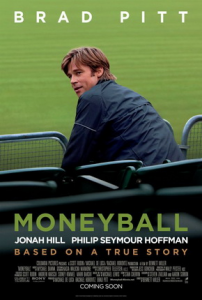
Today I watched “Moneyball”
Interesting. A few emotional moments. I don’t even like baseball. But I found the story of Moneyball fascninating
by justin
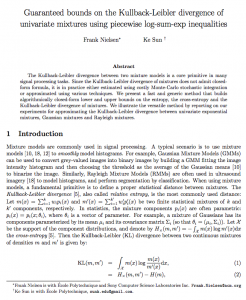
Guaranteed bounds on the Kullback-Leibler divergence of univariate mixtures using piecewise log-sum-exp inequalities
Today I read a published paper titled “Guaranteed bounds on the Kullback-Leibler divergence of univariate mixtures using piecewise log-sum-exp inequalities”
Some of the math was a bit obtuse, but a useful method that could be used for fingerprinting malware, tagging and label similar images using information divergence. The fact that this technique does not require a Monte-Carlo simulation is significant.
The abstract is:
The Kullback-Leibler divergence between two mixture models is a core primitive in many signal processing tasks. Since the Kullback-Leibler divergence of mixtures does not admit closed-form formula, it is in practice either estimated using costly Monte-Carlo stochastic integration or approximated using various techniques. We present a fast and generic method that builds algorithmically closed-form lower and upper bounds on the entropy, the cross-entropy and the Kullback-Leibler divergence of mixtures. We illustrate the versatile method by reporting on our experiments for approximating the Kullback-Leibler divergence between univariate exponential mixtures, Gaussian mixtures and Rayleigh mixtures.
by justin
Getting good grades shows proficiency.
Getting a good grade doesn’t demonstrate to the world that you can effectively deploy what you have learned.
We would hope it does, but study after study has demonstrated that academic achievements bear little relation to later success in life.
I think education should concern itself more with teaching people how to apply an area of knowledge to solve a problem rather than just making sure the person has the knowledge.
The problem is, its very easy to teach a subject through rote learning and then test and measure a student’s recall of the lessons than it is to teach a student how to use knowledge and information to make the world better.
The easy option measures your ability to teach someone how to recall simple facts.
The hard option measures how effective the student can be after you have taught them to think.
by justin
Today I read a published paper titled “Virtual Windshields: Merging Reality and Digital Content to Improve the Driving Experience”
We are barely on the cusp of driver assistance devices in vehicles today. If full autonomous vehicles don’t get here first (I suspect they will for 99% of all daily driving), augmented reality and digital windscreens are a game changer.
The abstract is:
In recent years, the use of the automobile as the primary mode of transportation has been increasing and driving has become an important part of daily life. Driving is a multi-sensory experience as drivers rely on their senses to provide them with important information. In a vehicular context human senses are all too often limited and obstructed. Today, road accidents constitute the eighth leading cause of death. The escalation of technology has propelled new ways in which driver’s senses may be augmented. The enclosed aspect of a car, allied with the configuration of the controls and displays directed towards the driver, offer significant advantages for augmented reality (AR) systems when considering the amount of immersion it can provide to the user. In addition, the inherent mobility and virtually unlimited power autonomy transform cars into perfect mobile computing platforms. However, automobiles currently present limited network connectivity and thus the created augmented objects are merely providing information captured by in-vehicle sensors, cameras and other databases. By combining the new paradigm of Vehicular Ad Hoc Networking (VANET) with AR human machine interfaces, we show that it is possible to design novel cooperative Advanced Driver Assistance Systems (ADAS), that base the creation of AR content on the information collected from neighbouring vehicles or roadside infrastructures. As such we implement prototypes of both visual and acoustic AR systems, which can significantly improve the driving experience. We believe our results contribute to the formulation of a vision where the vehicle is perceived as an extension of the body which permeates the human senses to the world outside the vessel, where the car is used as a better, multi-sensory immersive version of a mobile phone that integrates touch, vision and sound enhancements, leveraging unique properties of VANET.
by justin
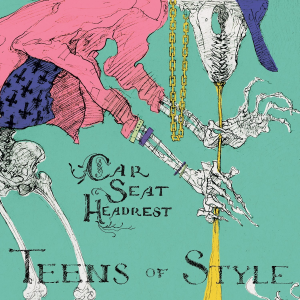
This week I am listening to “Teens Of Style” by Car Seat Headrest
by justin
I’ve never been happier in my life than those times when I wasn’t bothering to try and make other people happy.
I’ve never been unhappier in my life than when either I was trying to make someone (usually many someones) happy or when somebody thought it was my place to try and make them happy.
The power of “no” is a powerful word to use.
I have had occasion to use it quite a bit with some people.
Sometimes I would even follow up the word “No” with the words “Fuck off” and that made me even happier.
by justin

Getting Started with Twitter Flight
Today I read “Getting Started with Twitter Flight” by Tom Hamshere.
Needed some quick knowledge on an event API that I want to use for building an interactive infographic. FlightJS looks like it will do quite nicely for what I have in mind.
by justin
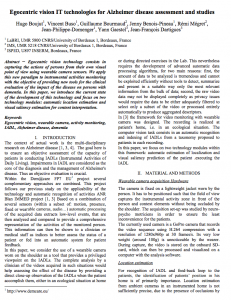
Egocentric vision IT technologies for Alzheimer disease assessment and studies
Today I read a published paper titled “Egocentric vision IT technologies for Alzheimer disease assessment and studies”
Sort of a SenseCam on steroids with applications towards helping Alzheimer’s sufferers. From what I read I believe this work is kind of early days yet, but it could hold great promise.

The abstract is:
Egocentric vision technology consists in capturing the actions of persons from their own visual point of view using wearable camera sensors. We apply this new paradigm to instrumental activities monitoring with the objective of providing new tools for the clinical evaluation of the impact of the disease on persons with dementia. In this paper, we introduce the current state of the development of this technology and focus on two technology modules: automatic location estimation and visual saliency estimation for content interpretation.
by justin
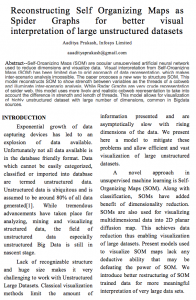
Reconstructing Self Organizing Maps as Spider Graphs for better visual interpretation of large unstructured datasets
Today I read a published paper “Reconstructing Self Organizing Maps as Spider Graphs for better visual interpretation of large unstructured datasets”
The abstract is:
Self-Organizing Maps (SOM) are popular unsupervised artificial neural network used to reduce dimensions and visualize data. Visual interpretation from Self-Organizing Maps (SOM) has been limited due to grid approach of data representation, which makes inter-scenario analysis impossible. The paper proposes a new way to structure SOM. This model reconstructs SOM to show strength between variables as the threads of a cobweb and illuminate inter-scenario analysis. While Radar Graphs are very crude representation of spider web, this model uses more lively and realistic cobweb representation to take into account the difference in strength and length of threads. This model allows for visualization of highly unstructured dataset with large number of dimensions, common in Bigdata sources.
by justin
Today I finished reading “The Walking Dead, Book Twelve” by Robert Kirkman
by justin
I do wish LinkedIn had a way to turn off the built-in message system.
But not “turn-off” turn-off.
I want something along the lines of “This user never reads their LinkedIn messages. To communicate with them, use the email address in their profile.”
by justin

This week I am listening to “The Book Of Souls” by Iron Maiden
by justin
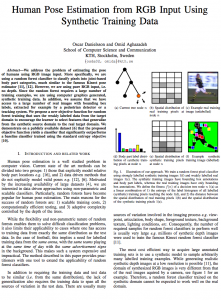
Human Pose Estimation from RGB Input Using Synthetic Training Data
Today I read a published paper “Human Pose Estimation from RGB Input Using Synthetic Training Data”
The abstract is:
We address the problem of estimating the pose of humans using RGB image input. More specifically, we are using a random forest classifier to classify pixels into joint-based body part categories, much similar to the famous Kinect pose estimator [11], [12]. However, we are using pure RGB input, i.e. no depth. Since the random forest requires a large number of training examples, we are using computer graphics generated, synthetic training data. In addition, we assume that we have access to a large number of real images with bounding box labels, extracted for example by a pedestrian detector or a tracking system. We propose a new objective function for random forest training that uses the weakly labeled data from the target domain to encourage the learner to select features that generalize from the synthetic source domain to the real target domain. We demonstrate on a publicly available dataset [6] that the proposed objective function yields a classifier that significantly outperforms a baseline classifier trained using the standard entropy objective [10].
by justin
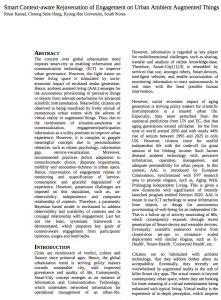
Smart Context-aware Rejuvenation of Engagement on Urban Ambient Augmented Things
Today I read a published paper “Smart Context-aware Rejuvenation of Engagement on Urban Ambient Augmented Things”
The abstract is:
The concern over global urbanization trend imposes smart-city as enabling information and communication technology (ICT) to improve urban governance. However, the light trance on better living space is stimulated by socioeconomic impact of escalated senior generation. Hence, ambient assisted living (AAL) emerges for the autonomous provisioning of pervasive things or objects from relevant perturbation for advanced scientific instrumentation. Meanwhile, citizens are observed in being transfixed by lively stimuli of monotonous urban events with the advent of virtual reality or augmented things. Thus, due to the involvement of situation-awareness or contextualization, engagement/participation information as a utility promises to improve urban experience. However, it is complex to grapple meaningful concepts due to personalization obstacles, such as citizen psychology, information gap, service-visualization. Moreover, recommended practices deficit adaptation to monochromatic choice, disparate impairments, mobility and annotation-richness in urban space. Hence, rejuvenation of engagement relates to monitoring and quantification of ‘service consumption and graceful degradation’ of experience. However, paramount challenges are imposed on this stipulation, such as, unobservability, independence and composite relationship of contexts. Therefore, a parametric Bayesian based model is envisioned to address observability and scalability of contexts and its conjugal relationship with engagement. Last but not the least, systematic framework is demonstrated, which pinpoints key goals of context-aware engagement from participants’ opinions, usages and feed-backs.
by justin
When you say something is good but are unable to express why it is good then your opinion is as valuable and valid as someone saying something is bad without saying why it is bad.
by justin
I created an email filter that shunts any emails with the phrase “looking for” followed by “unicorn|rockstar|genius” followed by “programmer|developer|CTO|engineer” straight to /dev/null
by justin
The defining characteristic of my wife is that she is of a generous and giving nature.
Mostly with my time and my money.